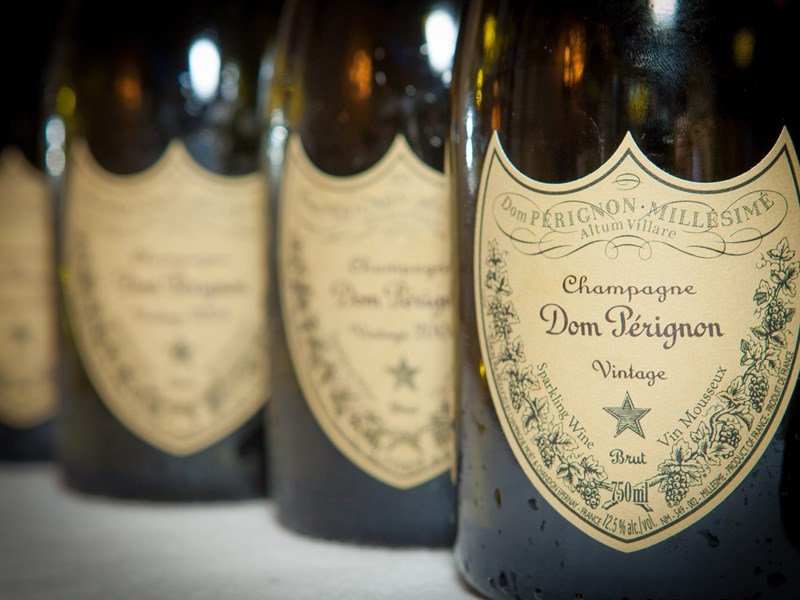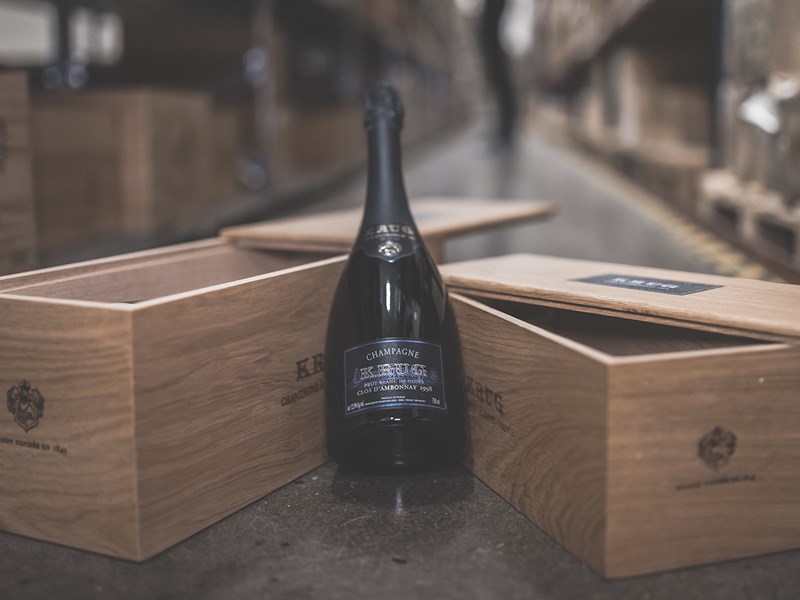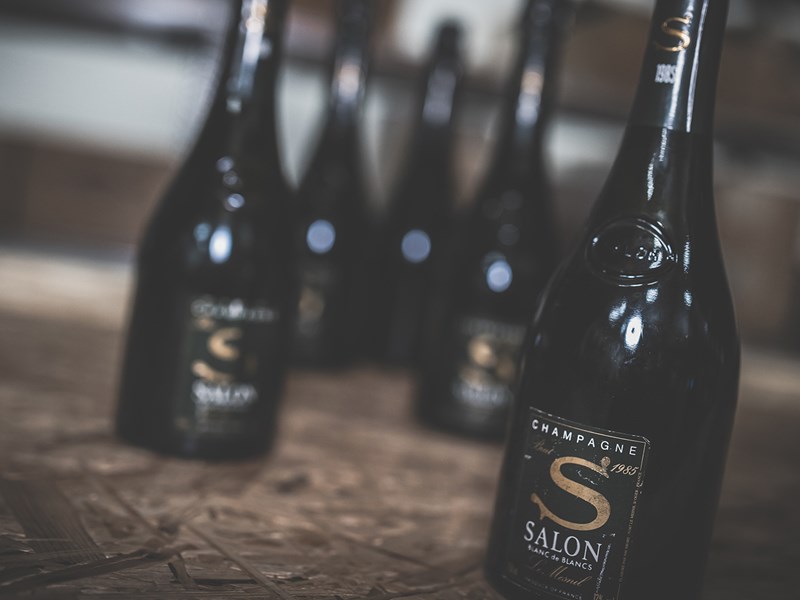Article - RareWine Academy
The Art Of Champagne Manufacturing
Not every sparkling wine is Champagne, but every Champagne is a sparkling wine. Get to know all about the exclusive and golden drops in this guide to Champagne production.
“I drink my Champagne when I’m happy and when I’m sad.
Sometimes I drink it when I'm alone.
When I have company, I consider it obligatory.
I trifle with it if I'm not hungry and drink it when I am.
Otherwise I never touch it - unless I'm thirsty”.
- Lily Bollinger
Here Is What You Need To Know About The Production Of Champagne
What is it that makes the sparkling drops from Champagne so much more desirable than sparkling wine from the rest of the world? Have you ever wondered how real Champagne is made? Take a look in this little guide, where we have collected everything you need to know to get started with Champagne.
The Champagne Region Is Ideal For The Production Of Sparkling Wine
First of all, there is geography. Champagne is located in the northwest of France and is a protected wine region. The vineyards in this area are considered some of the most expensive agricultural land you can get your hands on in the world. This area has both geographic and climatic conditions that stand out and make the area optimal for the production of sparkling wine.
Included is the soil, mostly composed of chalk, which helps to create the right pH balance in the grapes. It provides, from the beginning, the sufficient amount of acidity that is essential for the whole process. The different sub-areas of Champagne have different so-called "top soils" which, together with the climate, are suitable for different grapes. In total, there are five defined sub-areas, each of which contributes to the diversity, but also to the stability of the different winemakers.
The climate in Champagne is relatively cold in comparison with both the central and southern parts of France. This means for example that the grapes do not ripen optimally for red and white wine production. In this case, however, it is one of the main reasons why such beautiful sparkling wines can be made. The grapes build up optimal flavor complexity due to the long ripening period, but without building up too much sugar. Therefore, at harvest, the winemakers receive grapes that provide a base wine with about 11% alcohol.
Houses And Winemakers In Champagne
In Champagne, there is a clear differentiation between the big estates and the smaller winemakers. Today, there are more than 70 houses that are members of the Maisons de Champagne - an association of the largest producers. This includes everything from Moët & Chandon, to Bollinger to Pol Roger. These estates are responsible for most of the production, although they own only a few vineyards. Through strategic collaborations and contracts, they have ensured a stable supply of the best grapes each year.
The advantages of the big houses are stability in production, as well as a huge marketing effort that creates both interest and awareness of their own brand and of Champagne in general. Without the big houses and their marketing, Champagne would probably not have been as sought after as it is today. The big houses usually produce several series of wines, so there are an entry-level and all the way up to their famous prestige cuvées.
The vineyards in Champagne are owned by the winegrowers. 15,700 farmers cultivate 34,300 hectares of vineyards. Less than 5,000 of them produce and sell their own Champagne, the rest simply sell their grapes to the big houses. There are more and more of the last on the market these years. Many of them have perhaps more character and a much greater variation between cuvées and vintages.
 Dom Pérignon is by far one of the most recognized brands in champagne and is produced by Moët & Chandon.
Dom Pérignon is by far one of the most recognized brands in champagne and is produced by Moët & Chandon.
Classification Of Champagne
There are 318 villages in Champagne, all of which are classified in the "Échelle des Crus", which is rated between 80% & 100%. It is this rating that has proven to be the deciding factor in how much the winemaker can historically get for their grapes. Today, however, the price is set more like a negotiation between the winery and the grape producer. In some cases, quantity is what is sought, in others, quality. Classification also doesn't take into account whether you farm your vineyards according to organic, biodynamic, or sustainable principles. For example, with organic farming, you can generally expect up to 20% lower yields on a vineyard.
There are 17 villages that have grand cru status and therefore 100% échelle. 44 villages have premier cru status and are rated 90-99% échelle. The remaining villages are classified on a scale of 80% and higher. Can you then use that as a guarantee of quality? No, you can't.
The smaller producers will of course write on the label if their grapes come from one of the good classifications. The big houses will buy the best grapes but estimate that their brand is stronger than the classification itself. Dom Perignon, for example, has no classification on the label, but there is no need to doubt the quality of the bottle. Another example is Bollinger Grande Année, which is made from grapes from classified villages, but it is not mentioned on the label.
Grapes And Harvest In Champagne
In Champagne, there are three main grape varieties to know, Pinot Noir, Pinot Meunier, and Chardonnay. In addition, it is allowed to work with some other grape varieties, but in practice, this is done only to a small extent. All grapes are hand-harvested in Champagne to ensure they are pressed as quickly as possible and in whole bunches. The trick is that mainly blue grapes grow and most wines are white. So pressing must be done before the color comes out of the skins and into the must. Out in the vineyards, there are pressing houses where pressing takes place before the must is taken to the winery. In the vast majority of cases, the grape varieties are blended, but of course, each has its own character that contributes to the final wine.
In short, Pinot Noir gives body to the wine, Pinot Meunier is the workhorse that gives freshness and crispness, and Chardonnay gives backbone and precision. Wines are also neatly produced from the individual grapes, which can be of very high quality.
 The exclusive and sought-after Krug Clos d'Ambonnay is the perfect example of a single-plot vineyard where all grapes used in the final champagne origin from the same vineyard.
The exclusive and sought-after Krug Clos d'Ambonnay is the perfect example of a single-plot vineyard where all grapes used in the final champagne origin from the same vineyard.
Fermentation Of Champagne
For the production of sparkling wine, it is optimal to start with a base wine with just over 11% alcohol, which is helped by the climate in Champagne. These calm wines are called "vins claire" and have high acidity and low alcohol. It is these wines that must be blended to obtain the final Champagne. This is where the skills of the cellar master come into play. To blend the final Champagne, base wines from different grapes, different sites, and, in most cases, older wines are added to create the exact base wine that will become the house Champagne.
In the wildest cases, more than 100 different base wines are blended together, of which up to 40% can be from older vintages, so-called reserve wines. With this, the base wine is ready to begin its further journey into the cellar of the so-called duck fermentation.
NV means Non-Vintage and is the most normal designation for Champagne because the base wine is composed of several vintages. There are also single vintage Champagnes, but only if the cellar master feels that the vintage has the potential to make a unique vintage Champagne. It will often be these special vintage editions that have investment potential.
Second Fermentation Of Champagne
The wine is then bottled and 'Liqueur de tirage' added before being sealed with a beer cap. 'Liqueur de tirage' is a carefully measured amount of sugar and yeast that will ferment and develop exactly the desired amount of Co2 in the individual bottle. It results in sparkling wine with a pressure of about 6 bar and sediment in the bottle. The sediment is created by dead yeast cells and releases molecules that slowly combine with the wine and trigger the autolytic process. During this time, the Champagne develops its secondary aromas and flavors, which we often refer to as autolytic notes. They are notes of yeast, fresh bread, hay, and old flowers. It also adds a creamy mouthfeel.
In Champagne, the wine must age for at least 12 months before disgorging. Then another three months before release. However, most good Champagnes age for much longer and in theory will all have autolytic notes. In practice, however, there is a big difference in how distinct these will be, as it depends on how long each house leaves its Champagne before it is disgorged.
Disgorging Of Champagne
Disgorgement is the process by which the bottle receives its classic sparkling wine cork. The purpose of this process is to make the bottle ready for the market with a pure, clear wine and with the desired amount of sugar. First, the precipitate must be shaken to the neck of the bottle so that it comes out. This was traditionally done by shaking the bottles by hand, but today, of course, this is done by machine. Then the cap is frozen and the cork with the precipitate is pushed out by opening the bottle. The now clear wine, which has the desired bubbles, is then added to the dosage, which determines the degree of sweetness in the finished Champagne.
Finally, the bottle is closed with a classic Champagne stopper and steel wire, after which it is ready for the market. By far the most Champagne falls into the brute category, indicating a dry Champagne. The mild sweetness is perfectly balanced by high acidity, which makes the wine appear dry even with up to 12 grams of residual sugar per liter. The vast majority of producers today use 6 - 8 grams of residual sugar as dosage, which gives the style that the market demands.
 Extremely strict quality requirements and the ability to build Salon into a superbrand in record time, have made Salon the epitome of rare and sought-after among the world's champagne connoisseurs. With far fewer vintages released than, for example, Dom Pérignon and a production of only around 60,000 bottles in each released vintage, Salon has only released half a million bottles in the last 20 years.
Extremely strict quality requirements and the ability to build Salon into a superbrand in record time, have made Salon the epitome of rare and sought-after among the world's champagne connoisseurs. With far fewer vintages released than, for example, Dom Pérignon and a production of only around 60,000 bottles in each released vintage, Salon has only released half a million bottles in the last 20 years.
Champagne Is Perfection All The Way
In the best area, on the best and perhaps most expensive soil, and with grapes perfectly selected for the climate, you have the absolute most ideal conditions to create the perfect sparkling wine. This combined with a few generations of know-how about the work in the cellar and a little storytelling added, then you have the best and most sought-after sparkling wine in the world, Champagne - in all its simplicity, pomegranate, and splendor.
If you want to know more about Champagne, then read here how long Champagne can be stored or why Champagne prices will rise in the coming years.
